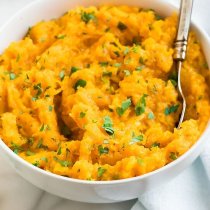Mashed Butternut Squash
Ingredients:
1 large butternut squash, about 3 to 4 pounds
2 T extra virgin olive oil, divided
1 T pure maple syrup plus additional to taste (You may substitute brown sugar)
1 tsp kosher salt divided, plus additional to taste
1/2 tsp black pepper divided, plus additional to taste
1/4 teaspoon ground nutmeg freshly grated if possible
1/8 tsp cayenne pepper optional
1/4 C almond milk or milk of choice use half and half or full-fat coconut milk for a richer flavor
2 T Parmesan cheese or nutritional yeast optional but very good
2 tablespoons chopped fresh parsley optional
(Some seasonings, herbs and cheese are optional for your taste. Omit the black pepper, cayenne cheese and parsley, if you plan to use the mashed or pureed squash in sweet or dessert recipes!)
Directions:
Place a rack in the center of your oven and preheat the oven to 350 degrees F. For easy clean up, line a rimmed baking sheet with parchment paper or aluminum foil.
Wash and dry the squash. Trim off the top and bottom ends, then carefully slice it in half lengthwise. (No need to peel it.) Scoop out the seeds. Place it cut-side up on the prepared baking sheet,
Brush the cut sides of the squash with 1 tablespoon of the olive oil and the maple syrup. Sprinkle with 1/2 teaspoon salt and 1/4 teaspoon black pepper, if using. Bake for 1 hour 15 minutes, or longer depending upon the size of your squash, until very tender and the squash pierces easily with a fork. Let rest until cool enough to handle.
Carefully scoop out the flesh and place it in the bowl of a stand mixer or a large mixing bowl. Add spices of your choice: nutmeg, cayenne, milk, Parmesan, parsley, and remaining 1 tablespoon olive oil, 1/2 teaspoon salt, and 1/4 teaspoon black pepper. Mash the butternut squash, either by hand with a potato masher, or with an electric hand mixer on low speed or stand mixer on low speed, until it is as smooth as you like. Taste and adjust the seasoning as you like. Enjoy hot.
To store: Place leftover mashed butternut squash in an airtight storage container in the refrigerator for up to 5 days.
To reheat: Gently rewarm mashed squash in a Dutch oven or skillet on the stove over medium-low heat, adding a splash of milk as needed for moisture. You can also rewarm this recipe in the microwave.
To freeze: Store butternut squash in an airtight freezer-safe storage container for up to 3 months. Let thaw overnight in the refrigerator before reheating.
To make ahead: Cut the squash in half, and store in the refrigerator for up to 1 day in advance. You can also cut, roast, and scoop out the squash ahead of time. Store the roasted squash in the refrigerator up to 1 day in advance, then finish the recipe as directed.
Story: Butternut Squash, one of the Three Sisters in American Indian cuisine, is a fall favorite to many! Native American farmers planted Sister Corn to provide a sturdy stalk on which Sister Bean could climb. Sister Squash with its big leaves shaded the ground around them all from hot sun and hungry animals. Original Local refers to the food ways of Native peoples, who called the western hemisphere home long before European settlers arrived. On October 12, alongside Columbus Day, many communities celebrate Indigenous Peoples' Day to recognize the culture, wisdom and contributions of those whose ancestors honored this land. Perhaps we can celebrate with some ancient local foods like the 3 Sisters, cranberries, foraged greens, wild rice, fish or game.
If you would like to be notified when we share new recipes, be sure to scroll to the bottom, provide your email address, check the box confirming you are not a robot, click on a few photos to prove it and click subscribe! You will then receive an email after each new post. Remember, we're always looking for new recipes, so keep sending them to ecopact@fspa.org!






Post a Comment